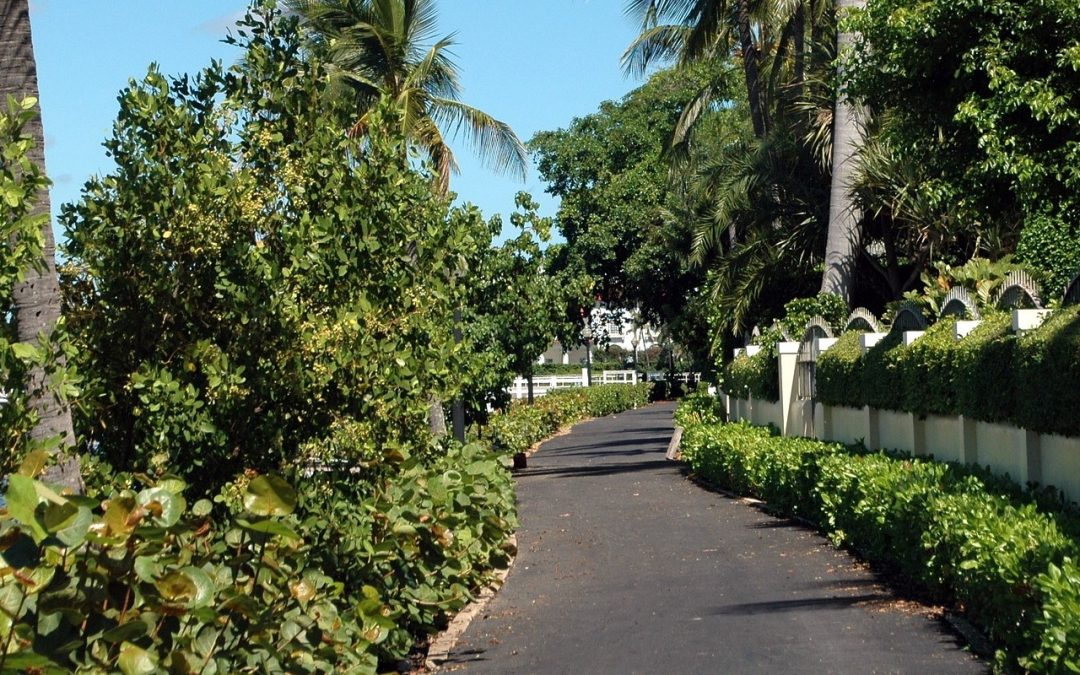Lawns in West Palm Beach, Florida, often look picture-book worthy, but that’s largely due to the near-perfect weather and homeowners selecting grass types that thrive in all that warm weather and tolerate both dry and rainy seasons.
First, a bit of background on that year-round summer weather and a challenge for lawn care in West Palm Beach:
— Some of the warmest winters in the country (on average only three nights per year dip below 40 degrees).
— Drought and rainy seasons (just over 2 inches in February to more than 8 in September).
— Nighttime watering restrictions that can slightly complicate caring for your green carpet.
So, how can you grow a great-looking lawn in West Palm Beach? Start with these three best grass types:
1. St. Augustine Grass
St. Augustine grass, with its blue-green color, is the most common turf variety in Florida. Its tolerance for salt that makes St. Augustine grass a good choice for West Palm Beach lawns.
Classification: Warm-season grass.
Spreads by: Above-ground stolons.
Shade tolerance: Above average. In full sunlight or partial shade, St. Augustine will grow quickly.
Drought tolerance: Extremely high. Unless a drought lasts a long time, St. Augustine grass will stay green and continue to grow.
Foot traffic tolerance: Average. A lot of footsteps will damage it.
Maintenance needs: St. Augustine grass sometimes produces a lot of thatch, which needs to be managed. St. Augustine is also susceptible to several grass diseases.
Recommended mowing height: Mow to 2 to 4 inches.
2. Bermudagrass
Bermudagrass has a high salt tolerance, a preference for heat, and a durability that make it ideal for lawns in West Palm Beach.
Classification: Warm-season grass
Spreads by: Above-ground stolons, underground rhizomes, and seed.
Shade tolerance: Below average. Even partial shade can harm Bermudagrass if it isn’t quickly returned to full sunlight.
Drought tolerance: Very high. Without watering, it will go dormant and turn brown. Once watering resumes, it will return to its previous green color.
Foot traffic tolerance: Above average. Bermudagrass can handle a high amount of foot traffic without issue.
Maintenance needs: It should be periodically inspected for pests and diseases. Excessive water can harm Bermudagrass, so good drainage is essential
Recommended mowing height: Mow to 1 inch.
3. Zoysiagrass
Zoysiagrass is dense and lush under most conditions, so picture it as the perfect lawn for your West Palm Beach home (feel free to picture blue skies overhead and palm trees on the near horizon, too).
Classification: Warm-season grass.
Spreads by: Both above-ground stolons and underground rhizomes.
Shade tolerance: High. Partial shade will not kill Zoysia.
Drought tolerance: Average. Zoysia will go dormant faster during drought than Bermudagrass, though thorough watering will make it lush and verdant again.
Foot traffic tolerance: Very high. The stiff blades of Zoysia spring back from even large amounts of foot traffic.
Maintenance needs: Frequent, small fertilizer applications are better for Zoysiagrass than larger quantities applied less often. Watering of 1 inch per week is ideal.
Recommended mowing height: Zoysia grows fast and will need weekly mowings to keep it at 1 to 2 inches.
Every lawn needs some maintenance, but choosing the right type of grass for the area can make the process easier. West Palm Beach has one of the most temperate climates in the country, so it’s important to pick a grass that likes the warmth as much as you do.
Need help caring for your lawn? Find advice and tips in our Seasonal Guide to Lawn Care and Maintenance.
Main image credit: Ren Waller / Pixabay

